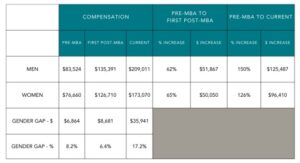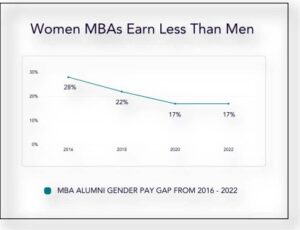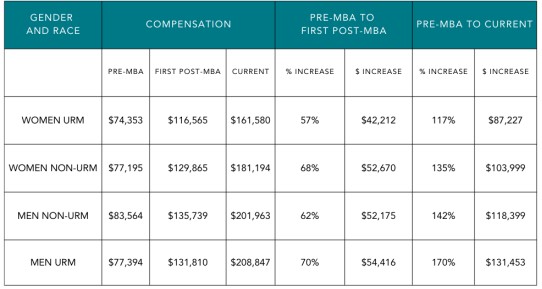FOR IMMEDIATE RELEASE
Forté Foundation study explores MBA pay and promotions gap, leadership barriers, and work-life issues
Austin, TX/May 18, 2023 – An MBA can boost the pay of women and minorities by 57% or higher in their first post-MBA job but does not eliminate the gender pay and promotion gap, particularly for underrepresented minority women, according to new research from Forté Foundation. The online survey of 1,476 MBA alumni was conducted between October 18, 2022, to November 21, 2022, by Forté, a non-profit focused on women’s advancement through access to business education. Michelle Wieser, Ph.D., Dean, School of Business and Technology at Saint Mary’s University of Minnesota, led the research. While there has been a slow and steady increase in women’s enrollment in MBA programs, the gender pay and promotion gap has been tougher to tackle. Key findings from the “Forté Foundation MBA Outcomes” research include:- Compensation: Women and men, including underrepresented minorities, see a substantial salary surge in their first post-MBA job, but pay gaps by gender and race emerge and widen.
- Pay Gap Over Time: The overall MBA gender pay gap for “current compensation” has narrowed from 2016 to 2022 but still exists, especially for underrepresented minority women.
- "Line” Versus “Staff” Roles: Men are more likely than women to hold “line” versus “staff” roles. Line roles (with profit and loss responsibility), pay more than staff roles (with no profit and loss responsibility), Forté found. However, women still make less than men when they hold line roles.
- Advancement, Leadership Barriers: Women don’t advance to the same level as men and have fewer direct reports. They are also less likely to have a documented career plan and to receive regular coaching and mentoring. Other barriers to leadership include lack of sponsorship, confidence, female role models, and, to a lesser degree, childcare challenges.
- Career Satisfaction and Retention: Women experience less career satisfaction than men, were more likely to change employers in the pandemic, and said they will do so again in the next year, led by underrepresented minority women. Top reasons for women’s lack of satisfaction? Their “career progression” and “current salary.” Top reasons for leaving? “Work culture” and “lack of respect.”
- Work/Life Issues: Men and women equally value hybrid as their “ideal work environment” but more women and underrepresented minorities said they “relocated to a new city because of the ability to work remotely” and more women “realized I wanted to work from home exclusively.” “The gender pay gap has narrowed since 2016 and 2018 but has not budged during the pandemic despite calls for pay equity and transparency,” says Forté CEO Elissa Sangster. “Women need to take on leadership roles with profit and loss responsibility to get on the CEO track. When they do, they earn more, but still less than their male peers. They also face greater barriers to leadership including lack of a formal career plan, sponsorship, and female role models – all things that can be addressed by company leadership, managers, and women – ideally working together.”
- Pre-MBA: Pre-MBA men earn $83,524 on average. Women earn $76,660, an 8% pay gap ($6,864).
- Looking at the intersection of gender and race, compensation was more closely aligned between the four groups pre-MBA, but women and underrepresented minorities (URM) earned less than men and non-URM: Women (non-URM $77,195; URM $74,353); Men (Non-URM $83,564; URM men $77,394). URM is defined as Black, African American, Hispanic or Latin American, Native American, or a combination of these, in Forté’s research.
- First post-MBA: Both genders see a similar percentage salary surge from pre-MBA to their first post-MBA job and the gender pay gap narrows to 6%, but the dollar amount widens to $8,681. Under-represented minority women continue to earn the least followed by non-URM women.
- In their first post-MBA job, women’s salaries jumped 65% or $50,050 to $126,710. Men’s salaries climbed 62% or $51,867, to $135,391.
- URM women had a salary gain of 57%, on average, or a $42,212 pay jump post-MBA, but earned the least ($116,565).
- Non-URM women had a 68% pay jump, or $52,670, to $129,865. Non-URM men did not see the biggest pay increase, but still earned more than every other group (62% pay increase, or $52,175, to $135,739).
- Current compensation: The gender pay gap widens to 17% or $35,941 from pre-MBA to current compensation. Men earn $209,011 currently, versus $173,070 for women.
- The biggest pay gap is between URM women who earn $161,580, on average, vs. URM men who earn $208,847, a gap of 23% or $47,267.
- Non-URM women earn $20,769 (10%) less than Non-URM men (non-URM women, $181,194, non-URM men $201,963).

 Gender Pay Gap Over Time
Gender Pay Gap Over Time
- The percentage decrease difference in current compensation between men and women in the 2022 study (17%) is the same as in Forté’s 2020 study. This has declined from a high of 28% in 2016 and 22% in 2018, but the gender pay gap did not narrow following the pandemic.
- This is consistent with Pew Research Center data released in 2020 that revealed the gender pay gap has been shrinking, especially among women in high managerial skill jobs.
- In March 2023, Pew found the pay gap has remained fairly constant over the last two decades, but is narrower among workers 25-34 than for women overall ages 16 and over.
- Pew cited that the pay gap “has been explained by measurable factors such as educational attainment, occupational segregation, and work experience. The narrowing of the gap over the long term is attributable in large part to gains women have made in each of these dimensions.”
 “Line” Versus “Staff Roles” and Pay
“Line” Versus “Staff Roles” and Pay
- Women and underrepresented minorities hold fewer line roles than staff roles. When women do hold a line role, they make significantly less than men. On an interesting note, URM women make more in staff roles than line roles, the only demographic group to do so.
- By gender, women hold fewer line roles (women 42%, men 47%) and more staff roles (women 58%, men 53%). This finding is consistent with a recent article in MIT Sloan Management Review that found women are stuck in support roles.
- By race, URM participants held fewer line roles (URM 41%, non-URM 45%) and more staff roles (URM 59%, non-URM 55%)
- The mean compensation for a line role was $207,005 and for a staff role was $180,727. This is a difference of $26,278 (or 14%). Women earn $33,864 (or 17%) less than men in line roles (women $184,105; men $217,969).
- When looking at the intersection between gender and race for line roles, URM women make the least, followed by non-URM women. (URM women $145,736; non-URM women $193,187; nonURM men $213,062; URM men $233,100).
- For staff roles, there are only statistically significant salary differences by gender, not race. URM women are the only demographic group to earn more in staff than line roles. (URM women $168,016; non-URM women $169,823; non-URM men $194,602; URM men $199,186).
- Men have received more promotions than women since obtaining their MBA with URM women receiving the fewest.
- Men have received 2.2 promotions since obtaining their MBA. Women have achieved 1.8.
- URM women have received the fewest promotions. (URM women 1.5, non-URM women 1.8, URM men 1.8, non-URM men 2.3 promotions).
- Men have more direct reports than women, particularly non-URM men.
- On average, men have 3.4 direct reports and women have 2.3.
- Non-URM men have the largest number of direct reports (3.5) followed by URM men (3) and women are about the same (non-URM women 2.3, URM women, 2.2).
- When looking at the ideal level of the organization five years out, more women than men are looking at mid-management while more men aim for C-suite roles, including CEO.
- More women (41%) than men (34%) are looking at the mid-management levels of Manager through Director. More men (35%) than women (30%) aspire to partner, C-level executive, president/CEO, and owner.
- Other top obstacles include a lack of sponsorship, female role models, confidence, and hesitancy to share ambition with leaders.
- Women were much more likely to cite a “lack of female leaders/role models” (women 37%, men 6%) and a “lack of confidence” (women 39%, men 28%).
- More women also pointed to leadership barriers such as “a lack of formal or informal sponsorship in the organization” (women 34%, men 27%) and their own “hesitancy to share their ambition with leaders” (women 17%, men 11%).
- While both women and men cited “children and childcare challenges” as a barrier to advancement, fewer women cited this versus lack of sponsorship, female role models, and confidence. Surprisingly, more men cited “other family concerns” as an obstacle.
- Women and men both cited “children or childcare challenges” as an obstacle (18% women, 14% men). More men cited “other family concerns” (14% men, 9% women).
- Women rated career satisfaction lower than men. (3.8 out of 5 for women, 4 out of 5, for men)
- Top reasons cited: “current salary” (women 3.38 out of 5, men 3.71), “number of people you manage” (women 3.48, men 3.72), and “career progression post-MBA” (women 3.85, men 4.08).
- One in five MBAs changed companies during the pandemic, led by women. Women are also more likely to say they will do so again in the next year, particularly URM women.
- More women changed employers during the pandemic (23% women, 20% men), especially URM women. (URM women 26%, non-URM women, 23%, URM men 22%, non-URM men 20%)
- In the next year, more women also plan to switch employers, including almost four in 10 URM women. (URM women 39%, non-URM women 28%, URM men 25%, non-URM men, 23%)
- The top reasons women left a past employer were “environment and culture were not a fit” (43% women, 36% men) and that they “felt disrespected at work” (30% women, 18% men).
- Men were more likely to leave for “better perks/benefits elsewhere” (23% men, 15% women).
- When asked about their current work environment, more women cited a lack of mentoring or coaching, as well as no formal plan for advancement.
- Fewer women than men say, “I have regular coaching and mentoring at work” (women 3.3 out of 5, men 3.5) and “I have a documented career plan” (women 2.8 out of 5, men 3.1).
- In the pandemic more women and underrepresented minorities said they “relocated to a new city because of the ability to work remotely.” (URM women 17%, non-URM women 15%, URM men 14%, non-URM men 10%)
- Even higher percentages “realized I want to work from home exclusively.” (URM women 28%, nonURM women 20%, URM men 17%, non-URM men 18%)
- The majority of men and women equally value hybrid as their “ideal work environment” (both 85%).Women are less likely to favor a 100% in-person or structured hybrid environment (women 26%, men 37%). They prefer 100% remote or flex hybrid, where they choose the days they work remotely. (women 74%, men 63%).










